In the event of a conflict, China must have the means to neutralize SpaceX’s Starlink internet satellites, according to a new essay by military researchers from the Middle Kingdom. Elon Musk has donated thousands of Starlink receivers to the Ukrainian military and is developing anti-jamming capabilities to counter Russia.
Posted at 12:00 a.m.
“A combination of destruction methods should be adopted to prevent certain Starlink satellites from operating and destroying the constellation’s operating system. Translated by a retired American diplomat on his blog and picked up by several technology media, this essay from the Chinese journal “Modern Defense Technology” does not surprise Kaitlyn Johnson, who has been following anti-satellite weapons for half a dozen years. China at the Center for Strategic and International Studies (CSIS).
Paranoia
“In China, the whole space program is controlled at least indirectly by the government and the military,” says Ms.me Johnson, whose most recent report was in April. “In my discussions with Chinese civilians and officials, I see that for them it is the same for SpaceX. »
They are convinced that the American army remotely guides Elon Musk’s choices.
Kaitlyn Johnson, Deputy Director and Researcher at CSIS
“It certainly isn’t, because Starlink has very limited use for the US military. It’s an internet link that’s too weak and imprecise,” she says.
Resilience
Would it be possible for China to cripple Starlink? “Not by destroying the satellites, there would be too many, even for the American army, says Mme Johnson. We are at 2400, and there will be tens of thousands more. But there might be interference from other Chinese satellites. At the moment, Russia is jamming Ukrainian Starlink receivers from the ground, but for that you have to be very close.
“Elon Musk has also announced that he was working on anti-jamming capabilities to help Ukraine,” she says.
The “just in time” space
Either way, the low cost of SpaceX launches makes it easier to replace destroyed satellites with Chinese missiles. The US Army is also working on a “tactical launch flexibility” program (tactically responsive launch), which is expected to receive $150 million in funding in 2023. “The idea is to immediately replace a satellite destroyed by the enemy,” says Mme Johnson.
In March, the military research and development agency DARPA ended a competition launched in 2016. None of the 18 firms selected had passed the test, which consisted of making two launches in less than two weeks – with locations, freighters and orbits unveiled at the last minute.
“The army is also working on its own constellation of small internet satellites like Starlink,” argues Mme Johnson.
Chinese capabilities
China is several years behind Starlink and SpaceX, says Mme Johnson. “They have several projects for internet constellations and small launchers capable of reacting quickly, but the focus has mainly been on large satellites and large launchers. »
The ABCs of Starlink
The first Starlink satellites, Elon Musk’s project announced in 2015, were launched in 2019. Internet coverage through Starlink is offered in 33 countries, and the first customers were connected in early 2021.
Starlink satellites are in low orbit, 340 km away, and weigh just over 225 kg. This low weight allows more frequent launches, which is made necessary by the low altitude. Indeed, a satellite in very low orbit plunges back into the Earth’s atmosphere more quickly. Each Starlink satellite has a lifespan of five years. This very low orbit also reduces the communication delay, which has the advantage of improving the quality of the internet signal.
Many astronomers are concerned, however, about the interference that the tens of thousands of Starlink satellites will cause with observations from terrestrial telescopes.
Learn more
-
- 400,000
- Number of Starlink customers in May 2022
Source: Starlink

